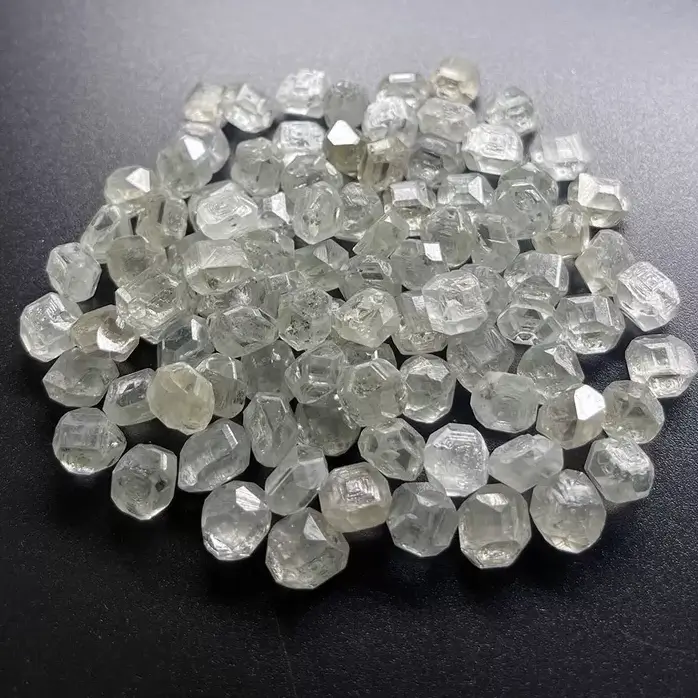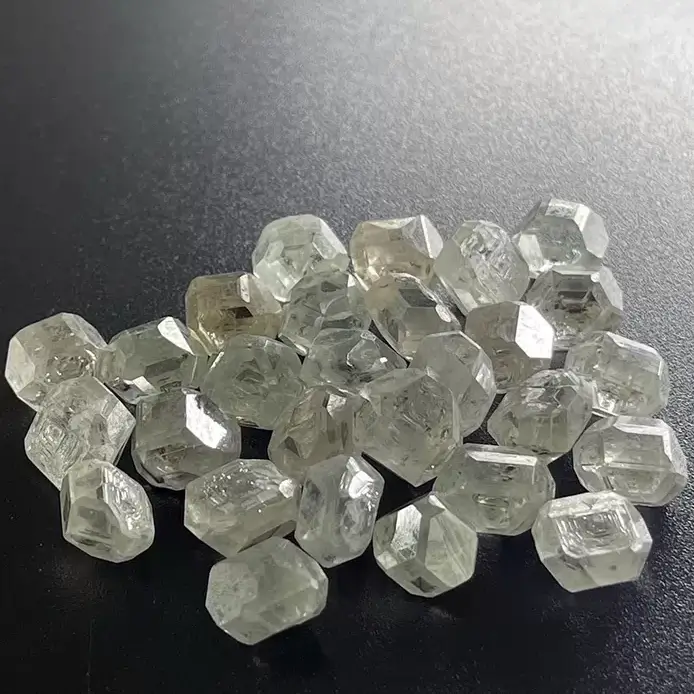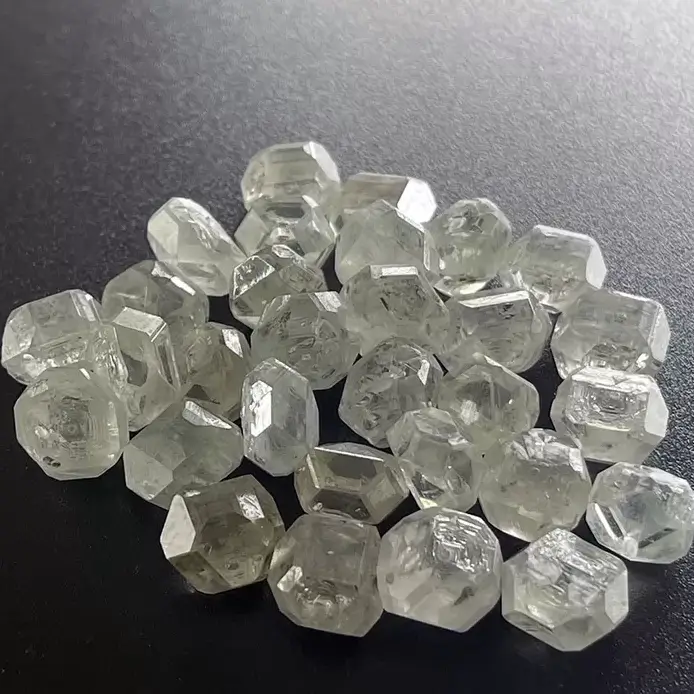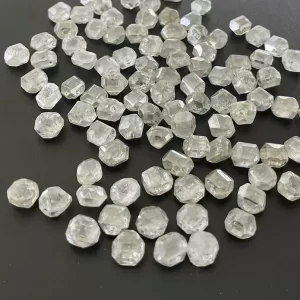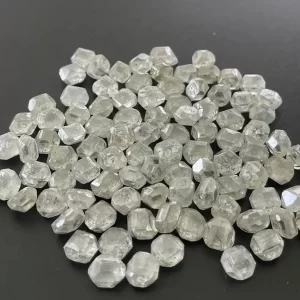Greenish HPHT Rough Fancy Colored Lab Diamonds 5 Carat To 8 Carat
5 Carat To 8 Carat Greenish HPHT Rough Lab Made Fancy Colored Diamonds For Making Fancy Color Stones
Lab Made Fancy Colored Diamonds Description
There are two main methods to make Rough Lab Grown HPHT Synthetic Diamond: one is high pressure and high temperature method (HPHT), the other is chemical vapor deposition method (CVD).
HPHT is the primary method used to grow rough diamonds in a laboratory. At present, the world’s popular high-temperature and high-pressure synthetic diamond equipment mainly includes two side top, six side top and bar split sphere or improved split sphere.Will Rough Lab Grown HPHT Synthetic diamonds be conflict with mined diamonds?Many people have similar worries: since diamonds can be created in lab, can they be mixed with natural diamonds? If I want to buy natural diamonds, will I be cheated by using the price of natural diamonds to buy lab diamonds?
With professional equipment, the comparison of the color, crystal shape and crystal surface characteristics, internal inclusion characteristics, absorption spectrum and ultraviolet fluorescence characteristics of the tested diamonds can “completely distinguish the artificially cultivated diamonds from the natural diamonds”. After all, natural diamond crystals were formed billions of years ago, while artificially cultivated diamonds can only be formed in a few days. There is no difference between the two, and it can be completely distinguished by professional testing tools.
Yellowish HPHT Rough Colored Lab Diamonds Or Greenish HPHT Rough Colored Lab Diamonds
When you are in the market for an expensive diamond, you may be wondering whether you should opt for the Yellowish HPHT Rough Fancy Colores Lab Diamonds or the Greenish HPHT Rough Fancy Colors Synthetic Diamonds. The answer to this question may surprise you. These diamonds are not only affordable, but also look real, and can be obtained for a fraction of the cost of the originals.
Yellowish HPHT Rough Fancy Colored Synthetic Diamonds
The production of yellowish HPHT rough Fancy Colored Synthetic Diamonds has recently begun in China. The first yellowish HPHT rough diamonds were produced in 2007-2008, and since then, the number of such diamonds has increased significantly. The high volume of HPHT synthetic diamonds produced will likely continue to rise, especially in extreme weights. Further, the diamonds’ spectral features will be increasingly similar to natural diamonds.
The yellowish HPHT rough colored synthetics display high concentrations of nitrogen-related defects, while their pink counterparts have lower levels of this element. The latter undergo a post-growth treatment that enhances nitrogen-related PL defects. As a result, the clarity of these yellowish diamonds will likely increase for some time to come. However, these synthetics are not the only color-changing diamonds available.
HPHT-grown synthetic diamonds grow as tiny individual crystals from yellow seed crystals. Most of the HPHT-produced melee is sold with seed crystals still attached. However, larger HPHT synthetic diamonds grow from the seed crystal face, resulting in a cuboctahedral crystal form. The process is repeated for larger HPHT synthetic diamonds with 111 octahedral or dodecahedral faces.
Fluorescence is another feature that differentiates HPHT-grown diamonds from natural ones. The HPHT synthetics exhibit weak fluorescence, which is not present in natural diamonds. In contrast, HPHT synthetics in blue and red color ranges generally show weak blue to orange phosphorescence. These differences should not deter consumers from purchasing an HPHT rough diamond. They are a great way to compare the quality of synthetic diamonds.
In the HPHT process, diamonds are exposed to a high pressure high temperature (HPHT) chamber. HPHT diamonds are heated up to 2,000 degrees Celsius and 60,000 atmospheres. These high temperatures cause a diamond’s color to change. For example, a yellow diamond may turn a bluish-greenish hue after the HPHT treatment. Similarly, a bluish-green diamond may develop a blueish-green tint.
The GIA identifies HPHT synthetic diamonds by body color. These diamonds were previously mostly yellowish orange or orangy yellow. However, they have gradually lost ground to blue and colorless HPHT Rough Fancy Colored Synthetics since the first years of production. GIA records show that blue and yellow hues account for 43% of HPHT synthetics submitted for grading.
The process of creating HPHT diamonds is the same as for creating natural diamonds, and it shares the same chemical and physical properties as its natural counterparts. Unlike natural diamonds, however, HPHT diamonds form much faster than their naturally-grown counterparts. HPHT diamonds are created by combining a small diamond seed with pure carbon. The carbon is heated to 2,000 degrees Fahrenheit, which melts the substance into a diamond. Once the carbon is cooled to the proper temperature, the diamond grows around the seed and forms around it.
Another critical analytical technique is photoluminescence spectroscopy (PL). This technique is highly sensitive, detecting optical defects at a lower concentration. It uses laser light of specific wavelengths to detect optical centers in the diamond. PL spectroscopy is an important analytical technique for determining the origin of a diamond, but it can also be used to identify the color source.
The process of HPHT processing creates diamonds with a yellowish hue. This color is produced by relieving internal stresses in the diamond’s crystal. After HPHT processing, the diamonds change from their original brown color to a yellow color. The HPHT process also reconfigures the C and A nitrogen centers, causing a contrasting change in color. Finally, they are annealed to bring about the final color.
Most HPHT synthetic diamonds are yellow. This is due to the presence of nitrogen impurities, which give them their yellow color. Boron and irradiation can also create diamonds of other colors. It is a good idea to check the color before purchasing a diamond. The yellow diamonds should be kept away from heat sources, as heat can change their color.
In most cases, HPHT synthetic diamonds show no fluorescence reaction when exposed to standard long-wave UV light. This makes the process of identification much easier. With DiamondView, the fluorescence reaction can be observed in real time. The high energy, short-wave UV source and facet surfaces of the diamond cause the fluorescence reaction. This reaction is highly distinctive, and cannot be achieved with a standard long-wave UV lamp.
During the process of making HPHT synthetic diamonds, the candidate diamond 100 is positioned inside an internal pressure-transmitting medium (IDTM) 202. This material is responsible for distributing the pressures uniformly over the diamond surface. The heat generating sleeve 204 may be made of tantalum, niobium, molybdenum, or pyrophyllite. Other suitable materials may also be used as refractory structures.
Since the discovery of yellowish HPHT, diamond prices have been rising steadily. The prices at De Beers sight have been significantly increased in the past week and Alrosa is expected to follow suit. As a result, the majors are getting closer to secondary market pricing. Meanwhile, smaller producers are also selling their rough well. These are often sold through the privately owned D.NEA company.
Diamonds are typically classified according to their color. Regular diamonds have a low saturation, while fancy dark or fancy light gemstones are high in saturation. In addition, fancy diamonds are also classified by tone and saturation levels. The color scale used by gemologists differs from manufacturer to manufacturer, and the difference can affect the quality of diamonds. You should always seek a lab-certified diamond for an investment.
When purchasing a diamond, be sure to look at it in natural and artificial light to see if its color matches your budget. Remember that color varies widely within GIA classifications, and this factor can have a dramatic impact on the price of a diamond. As a result, it is important to remember that diamonds with yellowish hues are usually discounted and considered less valuable than other diamonds. However, those with pink or blue hues are more expensive.
As a result of the differences in their growth characteristics and defects, HPHT synthetic diamonds can be difficult to differentiate from natural diamonds. With the proper analysis methods, they can be easily distinguished from one another. The Natural Color Diamond Association offers transparent information and educational materials about synthetic diamonds, as well as guidance to make the buying decision. With this information, consumers can confidently shop for a quality diamond and enjoy the peace of mind that comes with a high price tag.
Greenish HPHT Rough Fancy Colored Lab Diamonds 5 Carat To 8 Carat
